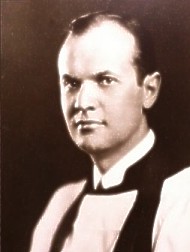Elmore McKee was a Yale-educated Congregational minister who rose to national prominence due to his serving in several
high-profile churches in the New England and New York area. His interests focused primarily on the practical day-to-day aspects
of the lives of his fellow man rather than on their spiritual side.
By the end of World War II, he was convinced governments too often serve their own needs and not that of their citizens. He
proposed a series of radio programs that would emphasize the good results that were possible when private citizens worked
together with little or no governmental involvement for some common public cause.
Elmore McKee
When his proposal was funded by the Twentieth Century Fund and the NBC radio network agreed to broadcast them nationally, McKee
began searching for examples. He learned of the Morganville-F�ves story from Lafe Todd which led to a short version of the tale
being broadcast on December 23, 1950.
McKee�s programs were so successful that he generated many of them over several years. Encouraged to write a book, he selected
those cases that he believed best illustrated his point. The Morganville-F�ves story, titled "One Affirmative Thing for Peace,"
was one of those in The People Act, the book first published in 1955.
McKee�s version is interesting because it was created from personal interviews with many of the people involved not long after the
events took place. But it may present some challenges for a present-day reader. The more important ones are identified below, as
well as what was done to address them.
The book was written in an easy-reading style for an American reader at the midpoint of the 20th century. As such, it contained
references that would most likely be unfamiliar to a modern reader or someone who was not raised in the United States.
In addition, McKee was nearing 60 when he wrote the book and was not a professional writer. Consequently, some
expressions he used and his manner of writing were already a bit dated, even by the standards of the mid-20th
century. For example: often it is confusing as to who made a particular statement.
Another problem so evident while watching a movie produced in the 1930s or 1940s is the acting and dialogue seem overly dramatic. For people of those times, this was expected. McKee was a writer and Velma Carson, the
primary person he interviewed for the book, was also a writer.
It seems certain that after the story passed through Carson and then McKee, the words chosen and the manner of
presentation were selected to meet the expectations of the times.
Book cover
Other problems include inaccuracies which frequently seem to originate from relying on the memories of the people interviewed. The
radio program script and the book were written several years apart and this occasionally leads to uncertainty as to when an event
happened.
In an effort to address these and other problems, explanatory material and modifications were added for a present-day
or non-American reader. This was done in five ways:
1. Occasionally items have been added in brackets within the text. It is intended they be read as if they had been part of
the original text.
2. Hyperlinks were inserted for certain words or phrases. Selecting a link will redirect the browser to
additional explanatory material.
NOTE: The browser's "BACK" button will return the reader to the original page location.
3. There were no photos or other graphics in the book. When appropriate graphics could be found or created, they
were included.
4. When errors in the mechanics of writing were encountered ... such as leaving out a comma ... they were either corrected
without note or allowed to remain if the meaning was clear.
5. When errors of fact or impression were discovered, they were handled in various ways. For example: It is clear that
McKee created one version of the story in 1950 for the radio broadcast and then "updated" it about 1954 for the book - the
latter version being the one presented here. Read as written, the reader could conclude that Emile Pierson was the F�ves
mayor when the story began and he was replaced by August Berne who died in office. This is not so. Berne was the mayor
from 1945 until his death in 1951 when Pierson replaced him until the subsequent election. It was decided to handle such
problems in whatever manner was the most seamless to telling the story.
With the exceptions noted above, the text beginning on the following numbered pages was that created by McKee. Unless otherwise noted, he is the "I" in the story.



